|
SYMPTOMS AND DETECTION OF COMMON BUNT 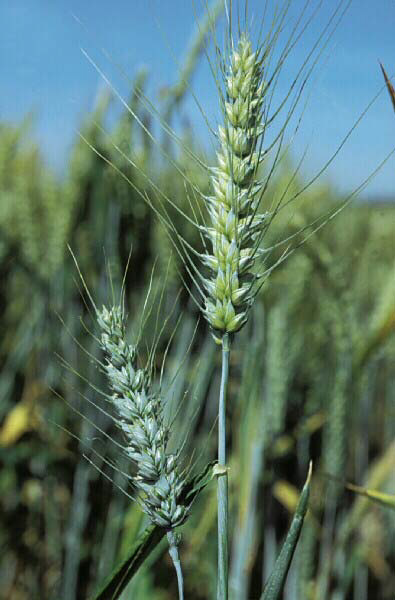 Common bunt on wheat goes almost unnoticed before heading. When observing the plants very carefully, a sharp eye might notice slightly shorter plants and increased tillering, with softer tillers. The number of headed stems per plant is reduced due to small or sterile ears. The shortening of plants is not systematic, as it depends on the wheat variety and type of common bunt pathogen. (adjacent picture, © Arvalis) 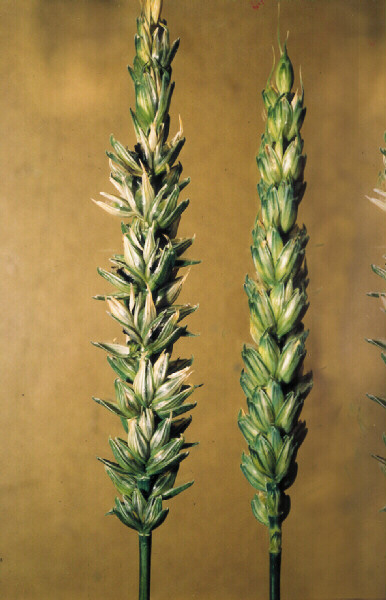 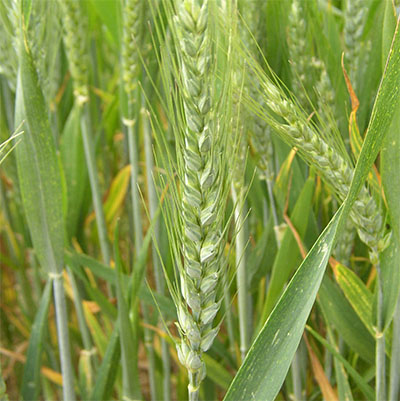 At heading, leaves and seeds might appear of a blue-greenish, glaucous colour, depending on the variety. This glaucous colouring is more visible on the ears, as well as a delayed maturation. Dishevelled-looking ears may reveal diseased, brownish-black kernels (photos opposite), but this depends on the level of contamination. At heading, leaves and seeds might appear of a blue-greenish, glaucous colour, depending on the variety. This glaucous colouring is more visible on the ears, as well as a delayed maturation. Dishevelled-looking ears may reveal diseased, brownish-black kernels (photos opposite), but this depends on the level of contamination.left: dishevelled / messy looking ear compared to a healthy one, with formed kernels (© Arvalis) right: ears may begin showing this dishevelled / messy aspect as early as flowering time (© ITAB) Symptoms observed during threshing : - Formation of a black cloud (if strong contamination) - Strong foul-smelling odour If you notice these symptoms during threshing without having earlier observed the symptoms on the ears in the field, it is advised to clean the your harvesting equipment thoroughly before harvesting other plots to avoid contaminating them. Very few bunted ears in a field (0.1%) can be enough to emit a smell of rotten fish (due to the presence of trimethylamine). However, this odour does not appear systematically, even at higher levels of contamination. -The bunted kernels are smaller and more spherical, they are filled with bunt spores (called "bunt balls", see picture below left) - Grains can also carry bunt spores on their surface, generally on the brush and in the crease, after bunt balls have burst and released the spores in the harvested lot of grains. (picture at the lower right). Using such grain as seed should be avoided. 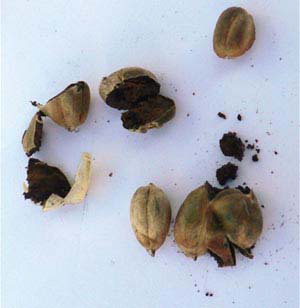 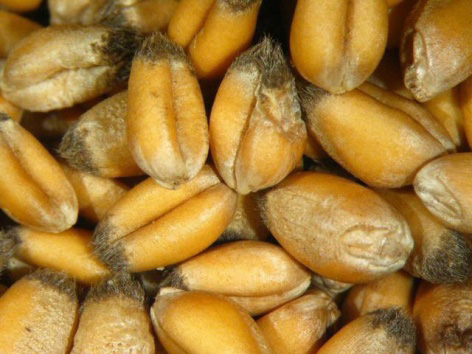 Photos ci-dessus: Grains cariés, aussi appellés "balles sporifères" à gauche (© CA77). Grains boutés à droite (© Arvalis) Detection Tests de détection de la carie The visual detection of bunt, whether in a plot (observation of the ears) or in a seed lot (presence of bunt spores), is very difficult and random, especially when contamination rates are low. Careful attention should be paid to avoid spreading bunt, which could lead to much higher levels the following year and contaminate the soil. An accredited laboratory analysis is the safest way to detect bunt. Plant pathology laboratories carry out the detection of bunt spores as a service to seed companies or farmers. The price for detecting spores in seed samples can vary between 30 and one hundred euros excluding tax. These tests are mandatory for seed companies in most European countries and highly recommended for farmers using farm-saved seeds. A sample of about 50 grams (about 1000 kernels) is required for analysis. When taking a sample, sample several places in the silo to be as representative as possible. Un
échantillon d'une 50aine de grammes (environs 1000 grains) est
nécessaire pour l'analyse. Lorsque vous prenez votre échantillon,
multipliez les points de prélèvement dans le silo pour être le plus
représentatif possible. Les différents types de tests The official test for detection is a filtration test, including the identification of bunt species and a spore count. It detects the presence of spores on the grains and quantifies them. However, this test does not differentiate between viable and non-viable spores. This requires an additional step in the filtration test, which measures the viability of spores by a staining method. The price of this test (filtration + viability measure) is of about one hundred euros. An early detection method has been developed by GEVES (in France) in the framework of the ABBLE project (2015-2018). It is now operational to check the infection of plants from the 3-leaf stage onwards. This test is performed plant by plant, on a part of the plant. As part of variety testing schemes, it will in future facilitate the identification of bunt-resistant varieties. The ABBLE bunt program will draft a protocol for testing wheat varieties for bunt resistance within the variety testing for registration as variety for organic farming. However, this test cannot currently be carried out on bulked samples, i.e. on a sample composed of several plants, for example from a wheat crop. A simple test to approximate the presence of bunt balls in harvested grain: the "bucket" test Put 5 kg of grain in a bucket filled with water. Stir and collect any floating kernels. Repeat stirring until no more kernels rise to the surface. Then inspect the collected floating kernels one by one and determine whether or not they are bunt balls (grain envelope filled with a black mass of spores). Attention! This technique allows to roughly detect bunted grains, but not exogenous contamination (i.e. spore residues from a poorly cleaned silo, the combine harvester, etc.). In the case of seed production (farm or certified), it can in no way be considered a substitute for laboratory analysis. (Manage common bunt) |

